Landslide!
Imagine the awesome event of a landslide. There’s no doubt it’s a brutal force of nature. If you’re unfortunate enough to be caught in one, you might not survive. A landslide is gravity pulling terra firma down a slope with such force that it takes all things, natural and manmade, with it. The very earth that supports us unmoors from its surroundings, changes shape, and becomes destructive. While it may not be obvious at first glance, this landslide can help us understand oil analysis.
Take a picture
Back to your mental image of the landslide: it starts off with a few pebbles rolling down a hill. Those pebbles strike others, and the dirt slide gains momentum. The process escalates and the mass of the movement increases. Larger rocks and patches of earth are dislodged, and the process continues until the whole hillside is involved, taking trees, boulders, and anything else in the way. Now stop: Take a mental picture of the landslide in full force. Step back and look at the frozen picture. Everything on the hillside that started off peacefully and at rest is in the process of roaring toward the bottom of the slope.
If you looked at your picture of the landslide from afar, you’d see a cloud of dust and dirt at the front edge of the sliding mass, and lingering far behind it. The dust cloud itself would actually hide much of the larger detail of rocks and trees crashing along the slope. Without looking at the larger debris contained in the mess, could you determine the makeup and extent of the landslide from the dust cloud alone? For the most part you could, and that’s how oil analysis works.
Normal vs. abnormal
One of the limitations to oil analysis is that we can only tell you about the wear metals that we can see with the spectrometer, which are between about 1 and 15 microns in size. (How big is a micron? One-millionth of a meter. One inch contains 25,400 microns. The period in this sentence is about 615 microns.)
If you have a mechanical problem with your engine, the oil filter should collect the larger metallic particles (usually those larger than 40 microns). These are the boulders in the landslide. There is also a wide range of rocks and stones present in the landslide that don’t become airborne. They still ride the slide to the bottom of the hill, but they don’t hang suspended in the dirt cloud. These are the particles that fall out of suspension and don’t make it to the lab with your oil sample.
Then there’s the dust cloud. We compare the “dust” we see in an oil sample to what is average for a particular type of engine, transmission, differential, etc. We expect all mechanical machines to produce wear in the course of normal operation. But there is normal wear, and there’s abnormal wear. When we find abnormal wear in your “dust cloud,” we may be looking at a potential landslide in your engine.
Avoiding the trees
Fortunately, we don’t have to wait for a landslide to occur before we can determine what’s going on your engine. While the dust cloud accompanying the slide is a one-time occurrence, we can repeatedly analyze the oil from your engine and see trends developing. One snapshot gives you a look at whether the dust we find appears normal or abnormal. But a series of snapshots gives us a clearer picture of the condition of the engine. By trending the results from one oil change to the next, we can see whether the dust cloud is growing or subsiding. If it’s growing, eventually there will be boulders and you’ll need to take action to save the engine.
Occasionally we are asked about the dust: How much is too much? In other words, when someone has a particular metal that’s reading high, they often want to know how high it needs to be before they really start to worry. The answer is, there’s no single answer.
Lots of things affect the amount of wear we find — the type of engine it is, how it’s driven, and what conditions it’s operated in. What’s more important than the level of wear is the wear trend that’s developing. Someone who routinely races a Subaru 2.5L engine in Las Vegas is probably going to find higher wear on a routine basis than a person who uses the same engine to mainly go to work and the grocery store in Minnesota. If the racer’s wear is always high, and it always reads at about the same high levels from sample to sample, we’d probably consider it normal for that particular engine. If the grocery-store engine was producing low, steady wear, and then wear suddenly jumped up to the racer’s levels, we’d worry. That’s why it’s important to establish wear trends for your particular vehicle, and why we can’t always say, “Okay, when iron gets to X level, it’s a definite problem.”
Avoiding the full-on, catastrophic landslide is not hard to do if you practice routine oil analysis. To keep the boulders and trees out of your engine, pay attention to what you find when you change the oil or have it changed. Some metals are normal in new engines, but once past 10,000 or 15,000 miles, you should not be normally finding any metals that you can see. If you do find metal, it’s probably not too late to stop the slide — but it’s better to avoid it in the first place, if you can, through the trend analysis of your engine’s wear.




